Water
News for March 2013
While you were drawing faces on Easter eggs, a lot of important things happened in the diverse and interesting world of water. Read on to hear all about it.
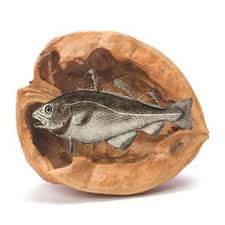 |
Water News in a Nutshell |
The strange, frightening and sometimes tragic phenomena called sinkholes, aka sinks, snake holes, swallow holes, dolines, and more, are natural depressions or holes in the Earth’s surface whose causes are shadowy and whose occurrence is usually unexpected. They are closely related to water and its mysterious ways.
Unseen Connections
by Janice Kaspersen, Editor, Stormwater
Sinkholes are in the news these days, both for their sudden and frightening appearances and for the implications they have for surface- and groundwater quality. This article from the New Yorker has a detailed and fascinating history of how and where they occur. It recounts, among other events, the 1999 disappearance of Florida’s Lake Jackson; the 4,000-acre lake emptied “like a bathtub emptying into a drain,” although the drain in this case was an 8-foot-wide sinkhole. Sometimes the lake would partially refill as water cam back up through the hole.
Where did the water go? And where was it returning from when it refilled the lakebed? The vast underground limestone caverns that underlie Florida and parts of several other states.
A sinkhole is what happens when a breach occurs between the underground realm and the surface—as it did in Lake Jackson, as it did several weeks ago underneath a house in a Tampa suburb, and as it does in hundreds of other cases, large and small, wherever such karst topography exists. The occurrence of sinkholes can be exacerbated by too much water—they tend to open more frequently during tropical storms, for example—as well as by too little water. In 2010, heavy irrigation (actually, the constant spraying of water on strawberry crops to keep them from freezing during a cold snap) lowered the water table in an area near Tampa by 60 feet in a week, and 140 sinkholes appeared.The porosity of the underground terrain, and the free movement of water through it, has some serious implications for water quality. Something that infiltrates the ground in one place can show up miles away. This article from Stormwater describes how the process works in West Virginia and how the Department of Agriculture monitors water quality there, in part to gauge what effect farming operations and crop fertilization are having on the water supply.) Urban pollutants in stormwater runoff are entering the aquifer, too. The New Yorker article says that Tallahassee used to recycle its treated wastewater by using it for farm irrigation, until it discovered several years ago that doing so was causing elevated nitrogen levels far to the south, in the Wakulla River, where no one had expected the irrigation to have an effect. The nutrients reach the river through the ground. Florida’s Department of Environmental Protection has taken to injecting dye into some sinkholes—much the same procedure, on a larger scale, that we use to detect illicit storm sewer connections—and seeing where it shows up downstream.
Source: Stormwater
Gazette Fair Use Statement
Sprite Shower Filters. You’ll Sing Better.
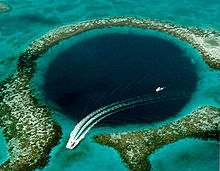 |
A famous sinkhole in Belize. |
Sixty-Five Dams Were Removed from American Rivers in 2012
America’s rivers are cluttered with obsolete dams. Programs led by American Rivers in partnership with other non-profit and government agencies are steadily working to get them removed. In 2012, 65 more old dams were taken down..
In line with a strong trend away from dams, communities in 19 states, working in partnership with non-profit organizations and state and federal agencies, removed 65 US dams in 2012.
Dams were removed from rivers in California, Connecticut, Georgia, Illinois, Maine, Maryland, Massachusetts, Michigan, Minnesota, New Hampshire, New Jersey, New York, North Carolina, Ohio, Oregon, Pennsylvania, Vermont, Washington and Wisconsin In total, the dam removal project restored 400 miles of streams for the benefit of fish, wildlife and people across the country.
Nearly 1,100 dams that have been removed across the country since 1912. Nearly 800 were removed in the past 20 years. American Rivers is the only organization maintaining a record of dam removals in the United States and uses the information to communicate the benefits of dam removal, which include restoring river health and clean water, revitalizing fish and wildlife, improving public safety and recreation, and enhancing local economies.
American Rivers is the leading organization working to protect and restore the nation’s rivers and streams. “The river restoration movement in our country is stronger than ever. Communities nationwide are removing outdated dams because they recognize that a healthy, free-flowing river is a tremendous asset,” said Bob Irvin, President of American Rivers. The top three states for river restoration through dam removal in 2012 are:
1. Pennsylvania – 13 dams removed
2. Massachusetts – 9 dams removed
3. Oregon – 8 dams removed
The complete list of dam removals in 2012 is available at http://www.americanrivers.org/2012damremovals.
Reprinted from the Pure Water Gazette.
Source Reference: Water Efficiency
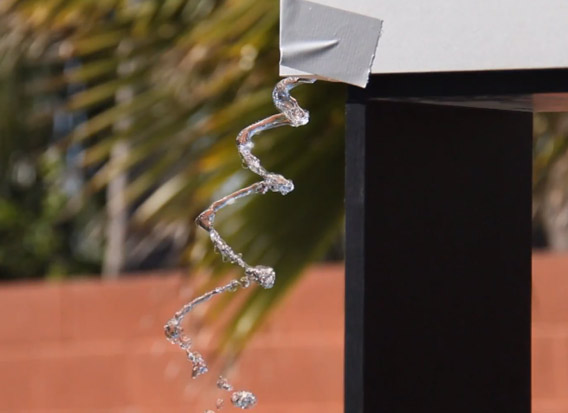 |
Water Spiral. Ever wonder why stagecoach wheels seemed to turn backward in the old western movies? For the same reason, water
can run uphill. See the explanation and the interesting video here. |
Multi-Pure (Oops, Multipure) Changes Its Design (Again) and the Spelling of Its Name
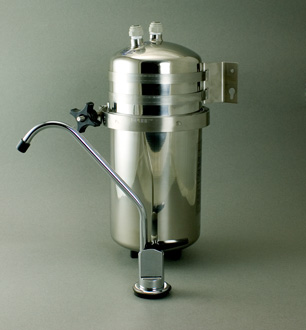 |
| The new Multipure VOC undersink unit. They've made the case taller (although the cartridge inside is the same) and put the inlet and outlet ports back on top as God intended. |
After three decades of inconsistency in the spelling of its name, Multipure, which used to be Multi-Pure and sometimes Multipure, has now officially announced that its name is Multipure. We're working on changing our websites.
Multipure has also re-revised
the basic design of it commercial VOC drinking water units, the new version being taller and having its in/out ports much more conveniently located on top once again. We applaud the change. We also applaud the much-improved mounting bracket.
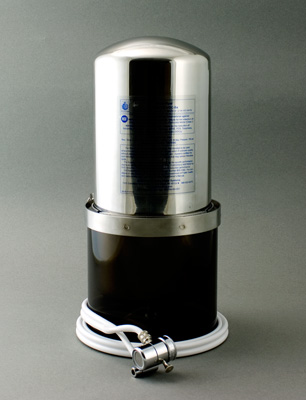 |
| The new Multipure VOC countertop is a "return" style that delivers water to the user's container via the diverter valve. The design does not require a spout. It is easy to install, easy to service. |
The good news is that the standard VOC cartridge fits the new units as well as the old, and it has the same extensive NSF certifications. It's a great water filter with an exceptionally long guarantee.
Multipure, following the practices of Multi-Pure, will not allow vendors to post prices lower than the company-listed retail, so you'll have to go to our website and click the "Add to Cart" button to find out the real price.
 |
| "Americans love their shrimp. It’s the most popular seafood in the country, but unfortunately much of the shrimp we eat are a cocktail of chemicals, harvested at the expense of one of the world’s productive ecosystems. Worse, guidelines for finding some kind of 'sustainable shrimp' are so far nonexistent." Read Jill Richardson's article in the Pure Water Gazette. |
| |
Water News Briefs
Lockheed-Martin recently received a patent on a new membrane technology they call Perforene. The company claims that the new membrane will greatly reduce the cost of converting sea water to fresh water. Details
World Water Day, a UN-designated event, was celebrated March 22, 2013.
A ten-million gallon tank in Detroit sprang a leak but fortunately only a million gallons of water were lost. Details.
North Dakota Water Commission officials say the state's oil industry used at least 5.4 billion gallons of water in 2012, an increase of 75 percent from 2011. More.
Repeated allegations were made that hunger strikers at Guantanamo were being denied water. More.
On Holy Thursday, the new Pope set off a heated
debate within the Church when he washed the feet of two young women at a juvenile detention center. More. |
WQA Aquatech USA 2013
The annual convention of the Water Quality Association of America will be held in Indianapolis this year, April 2 through April 5. The location is the Indianapolis convention center. The convention features conferences and product exhibitions and is generally regarded as the main event of the year for water treatment professionals.
More details from the WQA website.

|
The Fenwick boys water polo team (6-0) defeated cross-town rival OPRF 10-2. Other scores were 7-5, 13-2, 5-4, and 6-4. Details.
Read
the Occasional for occasional water polo coverage. |
How Alum Is Used in Drinking Water Treatment, and What Are Alum’s Health Effects?
One of the first of the several steps that municipal water suppliers use to prepare water for distribution is getting it as clear and as particulate-free as possible. To accomplish this, the water is treated with aluminum sulfate, commonly called alum, which serves as a flocculant. Raw water often holds tiny suspended particles that are very difficult for a filter to catch. Alum causes them to clump together so that they can settle out of the water or be easily trapped by a filter.
Usually a mixture of water with 48 percent filter alum is injected into the raw incoming water at a rate of 18 to 24 parts per million. The alum promotes coagulation of fine particles which helps resolve problems of color as well a turbidity. If the process is given enough time to work and is applied properly, it not only corrects problems in the water but actually results in removing most of the aluminum used in the process.
Although concern over the safety of treating water with aluminum has often been voiced, there is no evidence that aluminum in water, whether it comes from the aluminum sulfate used in treatment or from other sources, is a health issue. Actually, most aluminum that we take in does come from other sources. One study showed that only between 0.4% and 1.0% of our lifetime intake of aluminum comes from alum used to prepare municipal water. Most aluminum intake is from aluminum that occurs naturally in foods, aluminum used in food packaging, and from products like deodorants and vaccines.
Water treatment for aluminum is normally not needed, but aluminum is easy to remove with reverse osmosis or distillation.
See also “Simple Facts about Aluminum.”
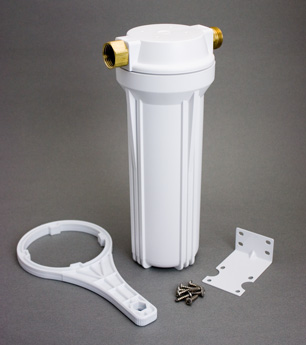 |
Official Garden Hose Filter Season Started the First Week in March. Now it's already April. Don't Be the Last on Your Block to Own a Garden Hose Filter.
Garden hose filters are among the most useful and the most versatile of water treatment devices. Recently we had a call from a gentleman looking for a way to remove chlorine from the water he sprays on the logs he uses to grow mushrooms. Nothing easier. A simple garden hose filter (either a single unit, or a double, like the one pictured above) can remove chlorine easily when fitted with a good carbon filter cartridge.
In fact, carbon
can remove chlorine (or chloramines) from water used to fill fish ponds, provide clean and healthful water for horses and other four-legged creatures, water organic gardens, or fill the kids' wading pool. In addition to carbon cartridges, there are specialty filters to
keep hard-water spots off of cars, to remove sediment to protect sprinkler heads, to improve the taste and odor of drinking water for outdoor workers, or even to remove small amounts of iron or rust from water for hot tubs.
In short, garden hose filters have dozens of uses. They are simple, easy to maintain, and inexpensive to purchase.
We have them in four canister sizes, in single and double versions (we'll make a triple or quadruple upon request), and in three colors.
If you don't have a garden hose filter, it's really hard to understand why. There may be something wrong with you.
More details. |
Water News of the Month
Below are links to March's posts in the Pure Water Gazette's "Today's Top Water Stories" section. Some are included
in this newsletter. Reading the Gazette's daily posts will make you wiser and some say it will slow down the onset of baldness.
 |
The Meaning of the pH of Water. Another Installment in Pure Water Annie’s Gripping Water Treatment 101 Series.
by Pure Water Annie
Pure Water Gazette Technical Wizard Pure Water Annie Explains A Few Things About the pH of Water and How It Affects Water Treatment
|
The term pH is used to describe the activity of the hydrogen ion in a solution. It measures the relative acidity and alkalinity of the solution. It is not a measure of quantity but of the relationship between acidity and alkalinity.
The pH scale ranges from 0 to 14, with a value of 7 considered neutral. Pure water is considered to be neutral, pH 7.0, although most water ranges between 6.0 and 8.0 on the scale. Values above 7.0 are considered alkaline and below 7.0 acidic.
The pH value of water decreases as the amount of carbon dioxide, CO2, increases, and pH increases as the amount of bicarbonate alkalinity increases. The ratio of carbon dioxide and bicarbonate alkalinity within the ranges of 3.6 to 8.4 is an indication of the pH value of the water.
The pH of water figures into almost all aspects of water treatment. The reduction of such contaminants as iron, manganese, arsenic, fluoride, and hydrogen sulfide is highly dependent on the pH of the water. Water that is low in pH is corrosive and must be corrected. Even disinfection of water with chlorine is highly dependent on pH.
As far as health is concerned, there is no evidence to support claims by sellers of pH amending machines that only highly alkaline water is suitable for drinking.
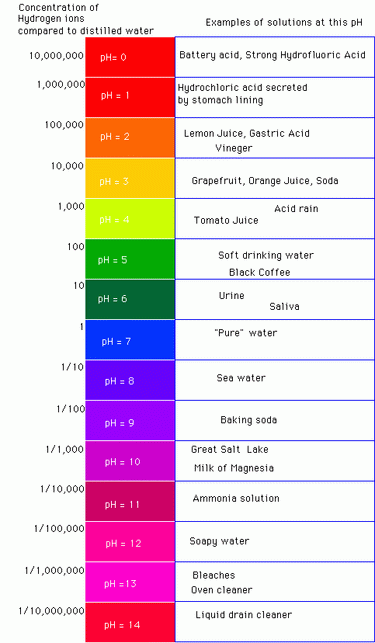 |
| The pH scale is a logarithmic scale. That means that each one-unit change in the pH scale corresponds to a ten-fold change in hydrogen ion concentration. In general terms that means that 8 isn't one higher than 7, it means that 8 is 10 times higher than 7 and 9 is 100 times higher than 7. Otherwise stated,
pH 10 is ten times more alkaline than pH 9 and 100 times
(10 times 10) more alkaline than pH 8, and 1,000 times more alkaline than pH 7. |
pH Adjustment in Water
The pH can be raised by injecting soda ash (sodium carbonate), caustic soda (sodium hydroxide), sodium bicarbonate, or potassium hydroxide into the water. Calcite (calcium carbonate, CaCO3) and/or Corosex (MgO—magnesium oxide) are used as filters to increase pH from the 5 and 6 range. The peak flow of neutralizing filters is limited to about 6 gpm per square foot of medium. Downflow filters must be backwashed frequently to prevent “cementing” of the bed. Upflow filters do not experience cementing of the bed, but they do not work if iron is present in the water.
Lowering pH is less frequently done, but can be accomplished by feeding a variety of acids with a standard metering pump. Both sulfuric and hydrochloric acids will work, but weaker acids are usually preferred. The most commonly used are phosphoric acid (H3PO4), acetic acid (CH3COOH), and citric acid (C6H8O7). Vinegar can also be injected to lower pH.
 |
Calcite Filter. The plug near the top can be removed to allow calcite to be poured in without removing the filter head. Calcite is slowly dissolved and "used up" as it raises the pH of the water, and more calcite must be added from time to time. More information.
|
Pure Water Gazette Now in a New Format
Our information-stuffed variety magazine, the Pure Water Gazette, has taken another turn. The Gazette started as a paper publication in the 1980s. The last paper issue was mailed in 1997. It has existed since as an information-rich website whose navigation and aesthetic properties were suffering from years from neglect. Although the old site can still be seen here, the best of the old content has been relocated to a much more manageable and search-friendly blog-style format. The new site is up and running as a work in progress with
over 400 articles and many more to come. At least one new article is added each day. The new site is at the old location, http://www.purewatergazette.net. Please visit!
|
